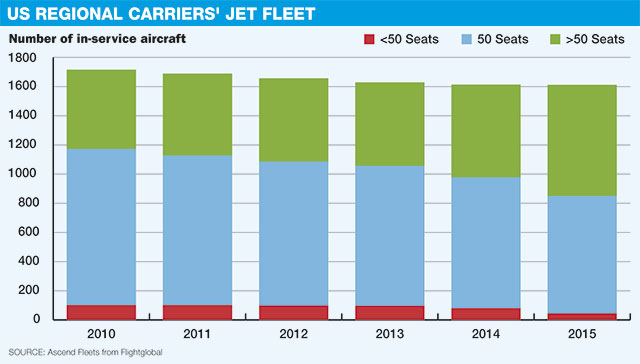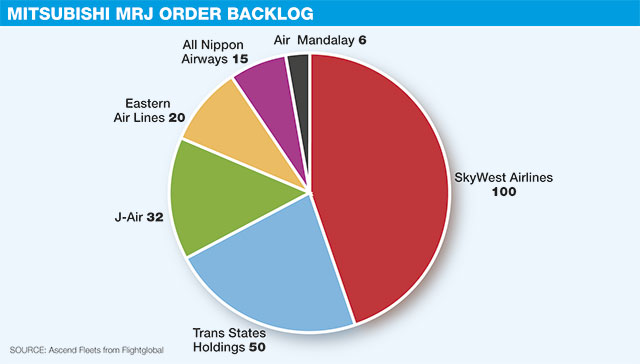Ascend aviation analyst Dennis Lau considers the impact new regional programmes may have on the market
With the upcoming first flight of the Mitsubishi MRJ, the Japanese manufacturer takes a further step in its challenge against Bombardier and Embraer in the highly competitive 70- to 100-seat regional jet market. Delays to the MRJ programme mean that first delivery will now take place more than four years behind schedule.
Mitsubishi last month disclosed a further delay to the MRJ programme – pushing first flight back from the second quarter to sometime in August/September – but is sticking to its plan for first delivery in the second quarter of 2017. The MRJ enters a highly competitive market currently dominated by Bombardier and Embraer. The majority of the 70- to 100-seat regional jet fleet is concentrated in the USA, where pilot scope clauses have a major influence on aircraft choice.

Existing scope clauses limit regional aircraft operating for the US majors to a maximum seat count of 76 and maximum take-off weight of 86,000lb (39t). With the typical two-class cabin configuration preferred in the USA, the MRJ90 can meet the seat-count limit, although its MTOW is some 1,300lb higher than the current limit.
The same hurdle is faced by the competing Embraer 175-E2, which has an MTOW of 97,730lb. The E175-E2 has logged 100 firm orders against 223 for the MRJ90. Both types have gained large orders from US regional carriers, with SkyWest Airlines booking 100 of each type – the only disclosed E175-E2 customer to date. Trans States Holdings has 50 MRJ90s on order. Both Mitsubishi and Embraer appear to be expecting further changes in US scope clauses by the time the new jets are delivered.
The current MRJ backlog also features launch customer All Nippon Airways, with 15 aircraft to replace the remaining Boeing 737-500s from 2017. Japan Airlines subsidiary J-Air confirmed its order for 32 aircraft in January and will operate them alongside J-Air's Embraer E-Jet fleet from 2021. J-Air also placed orders for five more E170s and 10 E190s in August 2014.

Although Mitsubishi is well known for its subassembly manufacturing in aerospace, producing large components for the Boeing 777 and 787, the company needs to prove itself in terms of whole-aircraft manufacture and support, especially in the competitive regional jet market. The delays have not helped the MRJ in gaining a time advantage, as entry-into-service will now be just one year ahead of its main rival – the E-Jet E2. Mitsubishi is also developing a smaller, 70-seat variant (MRJ70) and potentially a larger 100-seat variant (MRJ100X), which would make the MRJ a true competitor in the 70- to 100-seat regional jet market. The market is in a wait-and-see mode but no doubt keenly watching the developments and maturity of the MRJ programme. With major orders in the crucial US market, and plenty of replacement opportunities for ageing regional jets in the 2020s, programme execution will be critical to long-term sales success.
The rival Embraer E-Jet E2 is based on the successful current generation of E-Jets, although the 70- to 78-seat E170 will not become part of the E2 family. The E2 will be powered by the Pratt & Whitney PW1000G geared turbofan engine, which also powers the MRJ, and features new wings and avionics. The E175-E2 is stretched slightly over the current E175, and could increase the already significant Embraer presence in the US regional market if future scope clauses allow the higher MTOW.
The larger E190-E2 and E195-E2 are not suitable for the US regional market under current rules but have secured 225 orders to date. ILFC (now AerCap) was a launch customer with 50 orders split between the two variants, reinforcing the strong leasing potential for the E190 and E195.
Bombardier has been focusing on its single-aisle CSeries programme, and there has been limited development in the CRJ family over the past few years. The CRJ firm order backlog currently stands at 90 aircraft, around half of which are for the CRJ900. American Airlines is set to take delivery of 29 CRJ900s by the end of 2016, and these will be operated by PSA Airlines. There are few orders remaining for the CRJ700 and CRJ1000.
The CRJ family faces tough competition from Embraer and soon Mitsubishi, especially in the 76-seat US regional market. Current CRJ900 operator SkyWest has selected both the E175-E2 and MRJ90 to replace the CRJ900 in future. There are, however, more potential replacement opportunities as US regionals continue to phase out 50-seat regional jets in favour of larger 76-seat jets. Some 250 50-seaters are expected to be phased out over the next two years. The lower CRJ backlog means earlier availability for new aircraft.
The successful current Embraer E-Jet family has a backlog of around 250 aircraft. US regionals account for 58% of these with 145 E175s. There have been limited new orders for the current E-Jet during 2014 and into 2015, with an estimated 180-200 open slots remaining before production fully transitions to the E2. With over 570 options and letters of intent for the current E-Jet, it is likely that some of these open slots could be filled, although this could mean substantial pressure on pricing.
The regional jet sector also includes the delayed 78-92-seat Comac ARJ21 which is due to enter service later this year. It is likely to be China-focused, helping to develop new domestic links from secondary and tertiary cities. The Russian-built Sukhoi Superjet is seeing a slow increase in production and has seen limited export success, notably to Mexico, with most demand from its home market.
In the regional turboprop market, the focus still remains on the 70-seat category, with the ATR 72 and Bombardier Q400 being the only in-production types. ATR also offers the smaller ATR 42, with the Chinese Xian MA60 being its only in-production competitor. The current ATR order backlog stands at just under 300 against 50 for the Q400. ATR is increasing production to 100 by 2016.
ATR has had much success in recent years, especially in Asia-Pacific, where operators currently prefer the marginally better economics of the ATR 72 compared with the marginally higher capacity and speed of the Q400. The introduction of the 86-seat high-density Q400 may help it regain some lost share, although ATR has plans to offer an 80-seat version. ATR continues to grow its lessor presence, with operating lease companies accounting for 47% of the backlog.
Chinese manufacturer AVIC/Xian Aircraft (XAC) is set to enter the 70-seat turboprop market in 2019 with the PW150C-powered MA700. No firm orders have been announced to date, although Joy Air and Okay Airways will be launch customers. The market is likely to remain largely domestic to support the underserved Chinese regional markets, although AVIC/XAC is to seek US Federal Aviation Administration certification. This new design has potential to challenge the incumbent types and will have a cruise speed between the ATR 72 and Q400.
South Korea, Indonesia and India have all looked at developing 70- to 90-seat turboprops, although there have been few advances in these proposed programmes. The launch of a new 90-seat turboprop also appears to be moving further to the right, with ATR's plans stymied by the reluctance of shareholder Airbus to commit to the capital investment at this time. Ascend believes that at least one new programme will eventually be launched as the better economics of a 90-seater will in the 2020s prove attractive for replacing smaller 70-seaters.
Source: Cirium Dashboard























